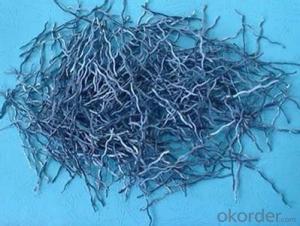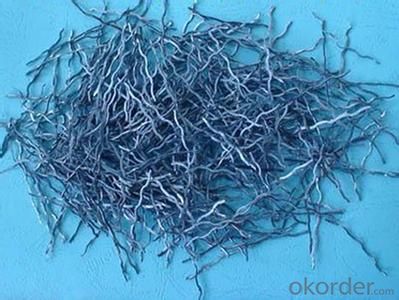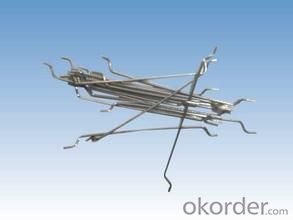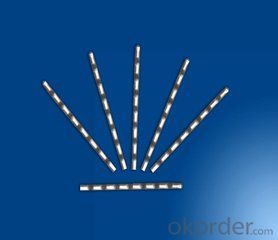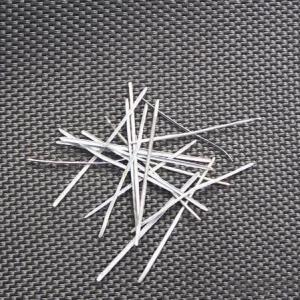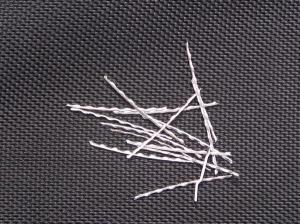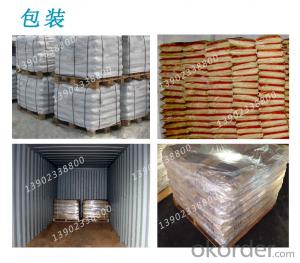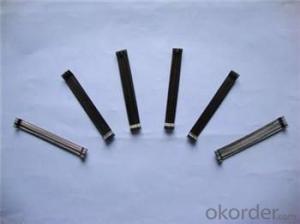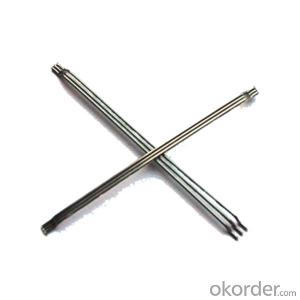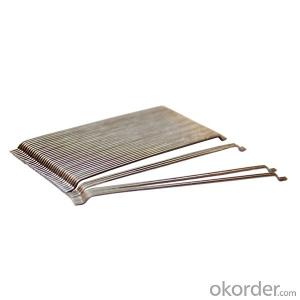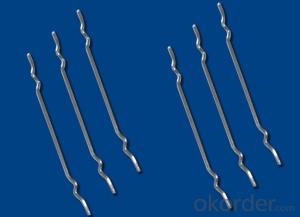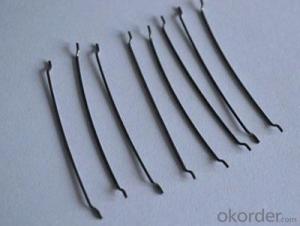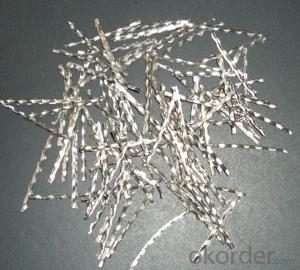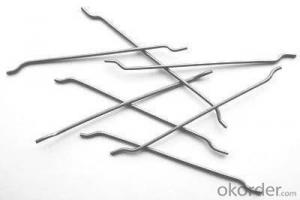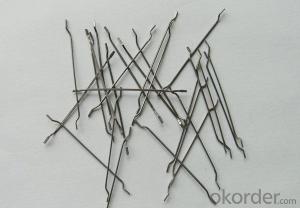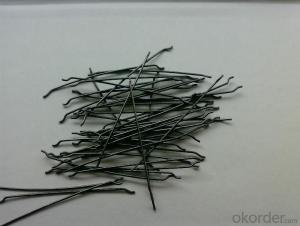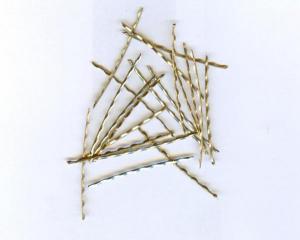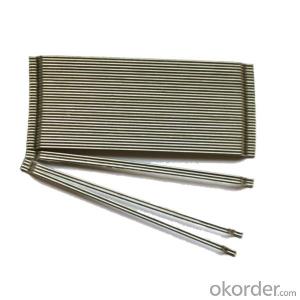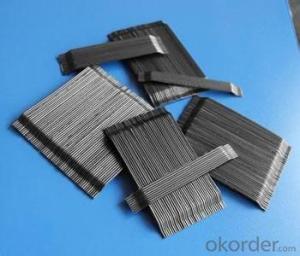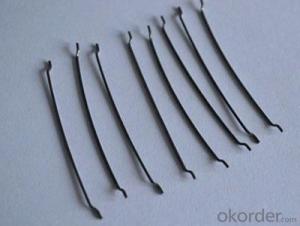Melt Extract Stainless Steel Fiber Low Carbon End Hook for Concrete CNBM
- Loading Port:
- Tianjin
- Payment Terms:
- TT or LC
- Min Order Qty:
- 2000 kg
- Supply Capability:
- 250000 kg/month
OKorder Service Pledge
OKorder Financial Service
You Might Also Like
Quick Details
Place of Origin: China (Mainland)
Material: Steel
material: steel wire
application: for concrete reinforcement
appearance: clean and bright
shape: steel fiber
Product features
concrete steel fiber is specifically to enhance concrete in its hardened state ,the uniform distribution of steel fiber throughout the concrete greatly improve concrete bonding and tensile strength ,additionally it provides exceptional load stability and durability ,as reliable and efficient concrete reinforcement material
it is widely ued in buildings ,bridges ,thin roo engineering ,highway etc.
Specifications
length :20-60mm
diameter :0.5MM-1.2MM
tensile strengh:>1100Mpa
diameter | length | tensile strength | |
0.5mm | 35mm | 1100Mpa | |
0.75 | 60mm | 1100Mpa | |
0.9 | 60m | 1100Mpa |
others can do according to your requirement
Picture
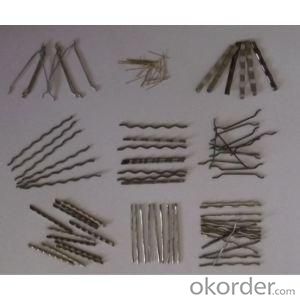
Steel fiber for concrete
concrete steel fiber is specifically to enhance concrete in its hardened state ,the uniform distribution of steel fiber throughout the concrete greatly improve concrete bonding and tensile strength ,additionally it provides exceptional load stability and durability ,as reliable and efficient concrete reinforcement material
it is widely ued in buildings ,bridges ,thin roo engineering ,highway etc.
FAQ
we can produce any type steel fiber and of course we can make production according to your requirement
we have specilize in this field for almost 10 years ,with good quality and competitive price
- Q: What is the effect of melt extract stainless steel fiber on the plastic settlement of concrete?
- The use of melt extract stainless steel fiber in concrete has a positive effect on reducing the plastic settlement of the material. The addition of stainless steel fibers helps to improve the overall performance and durability of the concrete by enhancing its resistance to cracking and shrinkage. When concrete is in its plastic state, it is vulnerable to settlement due to its high water content and the effects of gravity. This settlement can result in an uneven and weakened surface, compromising the structural integrity of the concrete. However, by incorporating melt extract stainless steel fibers into the mix, the fibers act as reinforcement, providing an effective mechanism to counteract plastic settlement. The stainless steel fibers help to distribute the stress and load evenly throughout the concrete, preventing concentrated settlement in specific areas. This even distribution improves the overall homogeneity and stability of the concrete, reducing the risk of cracking and surface deformations. Furthermore, melt extract stainless steel fibers have a high aspect ratio and excellent bonding properties with the cement matrix. This ensures that the fibers are well dispersed and securely anchored within the concrete, enhancing their ability to resist plastic shrinkage and settlement. Overall, the incorporation of melt extract stainless steel fibers in concrete significantly reduces the plastic settlement, improving the overall quality and longevity of the material. This leads to a more durable and structurally sound concrete that can withstand various external factors, such as load, temperature changes, and environmental conditions.
- Q: Is melt extract stainless steel fiber compatible with all types of aggregate?
- Melt extract stainless steel fiber is not universally compatible with all types of aggregate, I'm afraid. The compatibility relies on a variety of factors, including the aggregate's composition, characteristics, and the specific properties and requirements of the application. To achieve the desired performance, it is crucial to carefully consider the bonding, dispersion, and overall effectiveness of the fiber and aggregate combination. Seeking guidance from experts or manufacturers is highly advised to determine the compatibility of melt extract stainless steel fiber with different aggregate types for specific applications.
- Q: Can melt extract stainless steel fiber be used in high-density concrete?
- Yes, melt extract stainless steel fibers can be used in high-density concrete. These fibers are known for their high strength and corrosion resistance, making them suitable for reinforcing concrete in demanding applications. The addition of these fibers can enhance the overall performance and durability of high-density concrete.
- Q: What is the recommended fiber volume fraction for melt extract stainless steel fiber in concrete?
- The recommended fiber volume fraction for melt extract stainless steel fiber in concrete typically ranges from 0.5% to 2.0% by volume.
- Q: What is the recommended fiber content when using melt extract stainless steel fiber in concrete?
- Typically, the fiber content of melt extract stainless steel fiber in concrete is advised to be between 1% and 3% by volume. This range is deemed ideal for attaining the desired reinforcement and performance qualities in the concrete. Nevertheless, it is worth mentioning that the precise fiber content may differ depending on various factors, including the particular application, design specifications, and desired concrete properties. As a result, it is advisable to seek guidance from a qualified engineer or supplier to ascertain the suitable fiber content for a specific project.
- Q: Can melt extract stainless steel fiber be used in tunnel boring machine applications?
- Yes, melt extract stainless steel fiber can be used in tunnel boring machine applications. Stainless steel fibers are known for their high strength and corrosion resistance, making them suitable for use in harsh environments such as tunneling. These fibers can reinforce the concrete used in tunnel construction, improving its overall mechanical properties and durability. Additionally, stainless steel fibers can enhance the crack resistance of the concrete, reducing the risk of structural failure. Therefore, the use of melt extract stainless steel fiber in tunnel boring machine applications can help increase the longevity and safety of tunnel structures.
- Q: Does melt extract stainless steel fiber improve the impact resistance of concrete pavement?
- Yes, melt extract stainless steel fiber can improve the impact resistance of concrete pavement.
- Q: Can melt extract stainless steel fiber be used in combination with other types of reinforcement?
- Yes, it is possible to use melt extract stainless steel fiber alongside other forms of reinforcement. In concrete, stainless steel fiber is commonly employed as a supplementary reinforcement to enhance its mechanical properties. These properties include ductility, toughness, and resistance to cracking. To optimize the performance of concrete structures, stainless steel fiber can be combined with other forms of reinforcement, such as steel rebars or synthetic fibers. By combining various types of reinforcement, a synergistic effect can be achieved, leading to improved strength and durability. However, it is crucial to carefully consider the compatibility and suitability of different reinforcement materials. Additionally, the design and construction requirements must be taken into account to ensure proper integration and optimal performance.
- Q: Can melt extract stainless steel fiber be used in marine construction?
- Yes, melt extract stainless steel fiber can be used in marine construction. Its corrosion resistance and durability make it suitable for applications in marine environments where it will be exposed to seawater and other harsh conditions.
- Q: What is the effect of melt extract stainless steel fiber on the ductility of concrete?
- The ductility of concrete can be positively influenced by adding melt extract stainless steel fiber. Stainless steel fibers are renowned for their high tensile strength and exceptional resistance to corrosion, which can enhance the overall performance of concrete. By incorporating stainless steel fibers into concrete, they serve as reinforcement, imparting additional strength and stability to the material. This reinforcement aids in the even distribution of stress and load throughout the concrete, reducing the likelihood of cracking and increasing its ductility. Concrete infused with melt extract stainless steel fiber exhibits improved flexural strength, toughness, and resistance to impact and fatigue. These fibers create a network within the concrete matrix, effectively bridging cracks and preventing their propagation. This bridging effect heightens the overall ductility of the concrete, enabling it to endure greater deformation and uphold its structural integrity in various loading conditions. Moreover, the corrosion resistance of stainless steel fibers ensures that their mechanical properties endure over time. This long-lasting durability contributes to the sustained ductility of the concrete, even when subjected to harsh environmental conditions or aggressive chemicals. In summary, the addition of melt extract stainless steel fiber to concrete significantly enhances its ductility by providing reinforcement, enhancing crack resistance, and guaranteeing long-term durability. This advancement in ductility enables the concrete to better withstand external forces and maintain its structural integrity, making it a valuable inclusion in construction projects that necessitate high-performance and long-lasting concrete structures.
Send your message to us
Melt Extract Stainless Steel Fiber Low Carbon End Hook for Concrete CNBM
- Loading Port:
- Tianjin
- Payment Terms:
- TT or LC
- Min Order Qty:
- 2000 kg
- Supply Capability:
- 250000 kg/month
OKorder Service Pledge
OKorder Financial Service
Similar products
Hot products
Hot Searches
Related keywords
